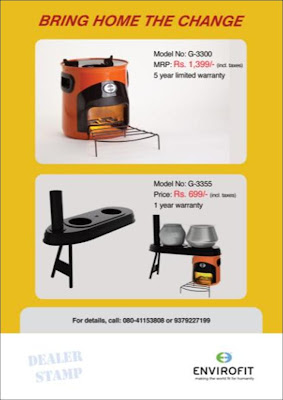This causes 1.5 million premature deaths each year, according to World Health Organisation (WHO) calculations. In developing countries, this makes Indoor Air Pollution (IAP) the most lethal killer after malaria, unsafe sex and lack of clean water or sanitation – yet, in comparison, this issue has a very low profile.
For the foreseeable future billions of people will continue to use wood, cowdung and crop leftovers as their main fuel. Therefore it is essential that efforts to reduce exposure to indoor air pollution be directed at the reality people face now. Smoke will continue to be produced, so it needs to be removed from the house.

Typical traditional cook stoves of south Karnataka can take either two pots or three pots at a time, and use firewood as fuel. The flame surrounds the main pot with some of the hot gases finding their way to the neighbouring pot/pots.
The efficiencies are generally quite low and are of the order of 10%. The kitchens are usually blackened with smoke. A masonry hood-chimney is sometimes provided, which helps in sucking the smoke upwards. The reasons for the low efficiency are not difficult to seek. The main reasons are:
a. Loss of heat through unburnt gases that are released in the air.
b. Radiation loss from the flame.
c. Cooling effect due to excess air factor.
d. Stove losses.
f. Incomplete combustion due to inadequate mixing of air.

Improved stoves were primarily designed to increase energy efficiency. The fuel-efficient ASTRA stove, with a thermal efficiency of 44%, was developed and about 1.5 million stoves disseminated in Karnataka. The level of acceptance was around 60%. The experience of Astra also showed the need for more stove designs to cater to the diverse cooking practices in different regions and clean combustion with improved efficiency.
Recently, organizations such as Envirofit and SELCO launched a range of clean burning biomass cookstoves in the country.
Designed by an international team of globally recognized scientists and engineers, the cookstoves made by Envirofit reduce toxic emissions by as much as 80%, while using 50% less fuel and reducing cooking cycle time by 40%. The cookstoves have been developed as a result of a partnership between Envirofit and Shell Foundation (UK).


According to a white paper by L K Atheeq, rural areas of Karnataka face indoor air pollution which leads to health related problems like breathing difficulties, upper respiratory infections and breathing difficulties. Besides, the lack of awareness among the rural poor about indoor air pollution and its consequences, these problems are also linked to the economic, social and cultural issues of the rural community. The paper also lists solutions, models current programmes and the way forward besides highlighting how the state is being impacted due to the issue, especially the rural poor.

